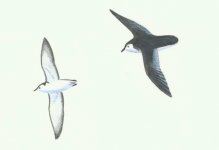Hi all,
Almost certainly had a Little Shearwater today from Galley Head,Co.Cork(picked up by Kevin Cronin at 9:15am and seen by 4 more observers,myself included).The bird was at moderate distance,and some features(the white face,the underwing pattern)could not be made out with certainty.
Nevertheless,what we did see is the following:
-size much smaller than Manx,with which it associated
-completely different flight,giving a slightly Common Sand-like impression(wings bowed in flight,bursts of quick stiff flaps interspersed with glides and half-hearted banking)
It was able to keep pace with the Manx,so the flight wasn't that slow,despite looking weaker(the odd "fluttery" Manx would fly much more slowly)
-2 of us(not me)saw a pale panel on the upperwing fleetingly
-wings more rounded,"paddle-shaped"
-more rounded compact "stubby" body,with short tail and rounded head(not as long at the front as Manx)
Utterly distinctive,NOT a Manxie and NOT an auk....
Could anyone with experience of Little and/or Audubon's please give their opinions on this?My gut feeling is that it was a Little,presumably baroli(but can the white face of this form be hard to see at a distance?Killian Mullarney(pers.comm.)has implied that this is usually obvious,but then our bird was often "half-banking",thus making this feature hard to evaluate),but I concede that other small shearwaters may be difficult to rule out.
I must add that all of us who were there have seen thousands of Manx in Ireland.
Harry H
Almost certainly had a Little Shearwater today from Galley Head,Co.Cork(picked up by Kevin Cronin at 9:15am and seen by 4 more observers,myself included).The bird was at moderate distance,and some features(the white face,the underwing pattern)could not be made out with certainty.
Nevertheless,what we did see is the following:
-size much smaller than Manx,with which it associated
-completely different flight,giving a slightly Common Sand-like impression(wings bowed in flight,bursts of quick stiff flaps interspersed with glides and half-hearted banking)
It was able to keep pace with the Manx,so the flight wasn't that slow,despite looking weaker(the odd "fluttery" Manx would fly much more slowly)
-2 of us(not me)saw a pale panel on the upperwing fleetingly
-wings more rounded,"paddle-shaped"
-more rounded compact "stubby" body,with short tail and rounded head(not as long at the front as Manx)
Utterly distinctive,NOT a Manxie and NOT an auk....
Could anyone with experience of Little and/or Audubon's please give their opinions on this?My gut feeling is that it was a Little,presumably baroli(but can the white face of this form be hard to see at a distance?Killian Mullarney(pers.comm.)has implied that this is usually obvious,but then our bird was often "half-banking",thus making this feature hard to evaluate),but I concede that other small shearwaters may be difficult to rule out.
I must add that all of us who were there have seen thousands of Manx in Ireland.
Harry H





